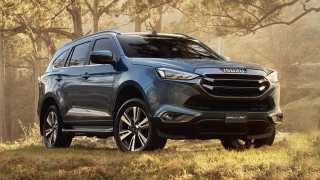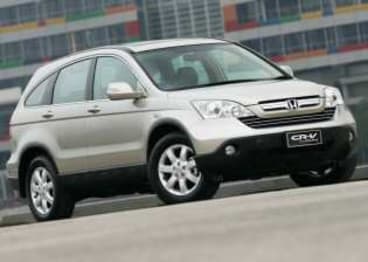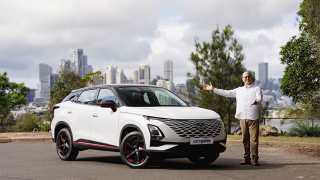
CR-V + VSA rules OK
Honda's ubiquitous CR-V, which has been steadily carving out a niche in Australia since 1997, is bigger, more powerful and safer than in previous years.
Originally designed as a limited market derivative of the Civic, the CR-V took off in Australia and by 2000 was the No. 1 seller in the Sports Utility Vehicle segment, outdoing Toyota LandCruiser and Nissan Patrol. It was also Honda's top seller in Australia for 1999, 2000, 2001 and 2002.
This year there are substantial changes to body and drivetrain. The arched window shape at the rear is probably the most noticeable change from last year while the front grille is different and the spare wheel has disappeared off the back door and now lives under the boot floor.
It is now sourced from Honda's Thailand factory rather than Japan.
If the rear door mounted spare wheel on the previous model is discounted, the new CRV is 100m longer, stands 20mm shorter, 35mm wider and has 70mm more passenger room. Its wheelbase is 5mm shorter, its front track 30mm wider and rear track 20mm wider. Ground clearance has been reduced by 20mm overall but that should not be regarded as a drawback for this bigger all-round CR-V.
While Honda talks about 4WD in brochures, the CR-V has not been designed with beaches or muddy tracks in mind. It really is a computer controlled all-wheel-drive system designed for greater traction on the road, (tarmac or gravel) rather than bush bashing.
Most of the time the front wheels are doing all the driving. It is only when there is a lack of traction up front that power gets sent to the rear wheels via a clutch on the rear wheels' driveshaft.
The CR-V receives Vehicle Stability Assist for the first time in 2007. The VSA system basically takes over the throttle and brake systems from the driver when the CR-V gets out of shape.
It uses the anti-lock braking system and wheel sensors, the electronic “throttle by wire” system and information from other sensors to detect whether the car is over steering (the back is sliding out), or under-steering (the front is going straight ahead rather that to the left or right where the wheels are pointed).
When it has all this figured out the computer applies the brakes to what ever wheels will rectify the situation while at the same time managing power by increasing or decreasing throttle opening and advancing or retarding the ignition.
VSA sounds highly complicated (and it is) but it works as seamlessly as the excellent transmission and the driver would not know it has assumed partial control unless he noticed the little flashing warning light on the dash.
The automatic CR-V as tested is wildly overgeared. If it revved right out in top gear it would be doing about 350km/h.
Obviously slowing engine speed in relation to road speed is a good way to save fuel but the CR-V, despite developing 7kW more than the previous model, whips down a couple of gears at even slight slopes if it is carrying four or five people.
That is no problem because Honda has developed an impressively slick and sophisticated auto which is not afraid to make the engine rev out to the 6500rpm redline.
It changes down a gear without any noticeable lurch or other drama. In many cases, especially if the driver is using cruise control, it is only the rev counter which gives the game away as it changes down in the hunt for more power to keep the 1600kg box shape SUV moving.
The onboard trip computer sheds light on why the CRV can be relatively thirsty. On the flat at a steady 100km/h it is using about 7litres per 100km. But if that speed is maintained up a slope and the SUV changes down a gear or two it will be using fuel at the rate of 15 or 16 litres per 100km. So if driven gently on the flat it will be pretty frugal but if you stick your boot into it, or try to maintain 100 or 110km/h with a full load, expect consumption to go up a bit given it is only a 2.4-litre four-cylinder engine moving 1620kg, which is more than the Rav4, Subaru Forester or Nissan X-Trail. Honda claims a combined consumption (urban and freeway) of 10L/100km. Leadfoots expect more.
The 2007 CRV comes with the usual Honda adherence to quality control. The finish is excellent and the cabin is practical rather than luxurious but with everything falling to hand. There are James Bond-style storage areas all over the place with enough room for sunglasses (in the roof lining) cups (centre and in the front doors), CDs (in the centre) and change (front, back and sides). Missing for 2007 is the integral picnic table which has been sacrificed for space to accommodate the in-car spare wheel.
The CR-V comes in three guises, Base, Sport and Luxury. We had both the Sport and Luxury in the CARSguide garage. The differences are in seating, wheels, sound system and parking sensors. The Luxury boasts leather heated seats and an electrically controlled driver's seat and the mag wheels are different on the Luxury. The sound system is slightly better and you get parking sensors, all for $2500.
SECOND OPINION
I'VE been checking our previous model Honda CR-V for a listening device.
Someone at Honda must have been listening to my conversations. It seems just about every modification in the new model has been in answer to my complaints, minor though they are.
The CR-V has been a model family car; economical, practical, stylish and dependable.
My complaints were that there was not enough legroom in the front, it needed audio controls on the steering wheel, there was too much road noise and the auto shifter being positioned on the steering column.
Now there is plenty of room for me to stretch out up front, the audio controls are easily accessible on the steering wheel, the road noise is substantially reduced and the shifter has moved to a more commonsense location by the centre stack like the Odyssey.
On top of all that there are some nice styling mods (except for the ugly inside door grips which look like bicycle cranks), clever little storage bins and cubbyholes, and the natty convex mirror above the rear-view mirror which allows you to check up on your kids: “Billy stop hitting your sister!”
The new model also handles and steers sharper than before and there is slightly more power in the daily driving range.
My only complaint is the relocation of the rear door spare tyre.
That tyre saved us an expensive fix in a minor rear-ender when my daughter was driving.
With the spare wheel now located under the cargo floor the handy picnic table and wet storage area have been scrapped.
Honda CR-V Price:$37,490-$41,990
ENGINE:Willing, but a bit of a screamer and noisy.
HANDLING: Good, for a tall, boxy, SUV
SAFETY: New stability control
ECONOMY: Good for lightfoots
VALUE: Top quality build
SPECS: ENGINE: 2354cc, inline, fuel injected, four-cylinder DOHC with variable valve timing
POWER: 125kW @ 5,800rpm
TORQUE: 218Nm @ 4,200rpm
TRANSMISSION: Six-speed manual, 5-speed automatic with grade logic control (as tested) real time 4WD
FUEL: ULP 91, 10L/100km (claimed)
WHEELS: alloy 6.5 x 17, full size spare
TYRES: 225/65 R17 102T
EMISSIONS: Euro 4/low emission vehicle
FOR: Roomy and slick transmission
AGAINST: Lacking in grunt, zales figures tell the tale
Pricing guides
Range and Specs
| Vehicle | Specs | Price* | |
|---|---|---|---|
| (4X4) | 2.4L, ULP, 5 SP MAN | $3,960 – 5,830 | 2007 Honda CR-V 2007 (4X4) Pricing and Specs |
| (4x4) Sport | 2.4L, ULP, 5 SP MAN | $5,720 – 8,030 | 2007 Honda CR-V 2007 (4x4) Sport Pricing and Specs |
| (4x4) Luxury | 2.4L, ULP, 5 SP AUTO | $7,260 – 10,230 | 2007 Honda CR-V 2007 (4x4) Luxury Pricing and Specs |
$2,000
Lowest price, based on 64 car listings in the last 6 months







